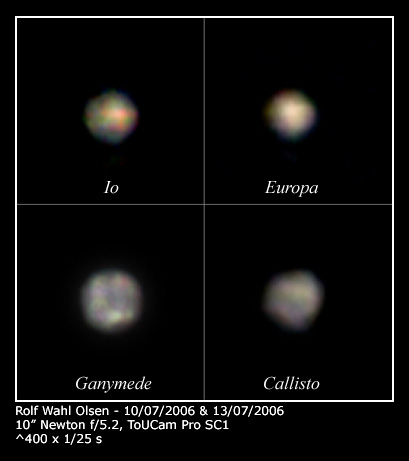Galilean moons
| ||||||||||||||||
|
This image shows the four Galilean moons of Jupiter, and their different colors and surface textures.
Clearly visible on Io are the dark polar regions, and in the right center is the red circular ejecta blanket sorrounding the large volcano Pele. Just at the bottom left of Pele is a very dark spot which is consistent with the location of the Babbar volcano. In the upper left of the disc is another dark spot, indicating the location of the Loki volcano. This volcano was violently erupting during Voyager 2's passage of Io in 1979. Large plumes of dust and gas are frequently ejected from these volcanoes to heights of several hundred kilometers above the surface. Europa does not show any significant details as it is mostly a uniform ball of ice and the famous lines and cracks which runs across it's surface are far too small to be seen at this scale. Ganymede is dominated by large dark plains called Regios, somewhat similar in appearence to the 'seas' of our own Moon. Also visible are a number of bright areas, which are light ejecta material sorrounding some of the younger impact craters. In the lower right is the bright area around Enkidu crater, with the darker Nicholson Regio above and to the left of the crater, covering most of the center of the disc. At the upper right edge is the bright Ta-Urt crater, and the left half of the disc is showing Tros crater and various bright areas around Mysia Sulci. This is a large system of rilles and canyons. Callisto is the darkest of the Galilean moons and does not show many details. However the bright area in the upper right is consistent with the location of the giant Asgard impact basin, and in the lower left is a smaller bright spot which may be the Bran impact crater, sorrounded by light ejecta material. | ||||||||||||||||
|
Back to Solar System | Back to previous page
